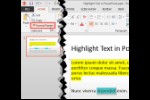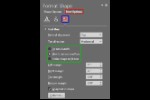Learn about Hue, Saturation, and Luminosity, and how you can use these properties to mix colors.
Author: Geetesh Bajaj
Product/Version: PowerPoint
OS: Windows and Mac OS X
We learned about the RGB Color model in a previous tutorial. And while computers can easily understand the fact that you mix red and green to end up with yellow, that's some strange logic to us humans which we shall never comprehend! For most of us, we understand that mixing yellow and blue makes green.
So how can we stay within the RGB color model, which computers understand, and mix colors more creatively to use a method which we humans can understand?
This need for a more creative model gave birth to the HSL (Hue, Saturation, and Luminosity) color model. Do note that HSL is not the same as the HSB color model. And really speaking, you don’t even need to bother. Yet, if you are curious to understand the differences between these similar yet not same color models, please read the information in the box below.
If you use a tool like Adobe Photoshop or most other graphic programs, you would have encountered the HSB (or HSV) color model. Microsoft Office applications including PowerPoint though use the HSL model rather than HSB (or HSV). For all practical purposes, HSB (Hue, Saturation, Brightness) and HSV (Hue, Saturation, Value) are the same. But HSL (Hue, Saturation, and Luminosity) is a wee bit different.
Not only is HSL different, but PowerPoint’s implementation itself is different too. In most programs, the Hue value is calculated between 1 to 360 (or 0) degrees. And the other two values are calculated in percentages from 0 to 100%. But in PowerPoint, all three values are calculated from 0 to 255 (256 values), so as to make it simple for everyday users who are familiar with how RGB values work! Is this approach good enough? We don’t know. But the upside is that if you know how RGB works, then you also know how HSL works in PowerPoint. But if you are using HSB in Photoshop or elsewhere, you will have to unlearn a bit!
By now, you must have observed that the main difference between HSB/HSV or HSL is the last character in the acronyms. So let us see what differs in between Brightness/Value and Luminosity. The visuals below will help you understand this better.


These pictures were sourced from Wikimedia Commons.
More detailed information can be found at the Codeitdown site.
Before we proceed further, you must understand that the HSL color model is a subset of the RGB model. The resulting colors are just the same. HSL is only a different method that uses property values rather than color values.
A color model is essentially a way to mix colors, values or something else to create new colors! Learn more in our Color Models tutorial.
The most used color model is RGB. RGB uses three primary colors: Red, Green, and Blue to mix and create almost 16 million colors. All these 16 million colors are essentially composed of different proportions of all the three primary colors: R, G, and B. Likewise, you can also create the same 16 million colors using the HSL color model. This color model uses properties such as Hue, Saturation, and Luminosity to create new colors.
For example, let's start with this basic red color swatch of red. In RGB terms, this swatch has a value of R:255, G:0, and B:0. That means there is nothing but Red in this swatch, indicated by the zero values shown next to Green and Blue. So why is Red set to 255? That's because 255 is the largest number value you can use for any RGB color. That means you essentially can choose from 256 number values (0 to 255) for each color: R, G, and B.
| Color | R | G | B | Swatch |
|---|---|---|---|---|
| Red | 255 | 0 | 0 |
HSL works the same way, and you can similarly have 256 values of Hue, Saturation, and Luminosity, each of them ranging from 0 to 255. Let's now explore the HSL values of the pure red color. Here they are:
| Color | H | S | L | Swatch |
|---|---|---|---|---|
| Red | 0 | 255 | 128 |
We will now explore what these H, S, and L values actually mean. To make things simpler, we suggest that you explore these three properties in the reverse sequence. All these three properties are explained in detail in the links below:
See Also:
Color Models: HSL (Index Page)
You May Also Like: Create Memorable Content: Conversation with Carmen Simon | Serbia Flags and Maps PowerPoint Templates




Microsoft and the Office logo are trademarks or registered trademarks of Microsoft Corporation in the United States and/or other countries.